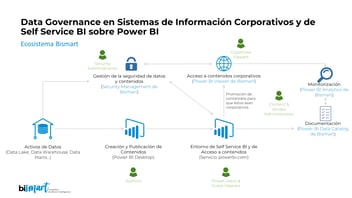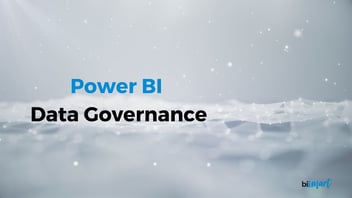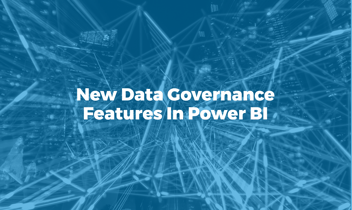Discover how to implement decentralized data management through a Data Mesh data architecture.
As the amount of data generated by organizations multiplies, companies are looking for more efficient ways to manage and leverage their data. Data Mesh architecture presents itself as an innovative solution that integrates data decentralization and data as a product (DaaP).
The exponential increase in the amount of data generated has brought a major emphasis on disciplines such as data governance and data quality.
In a context of over-information, the transformation of data into valuable insights no longer depends solely on the quantity of data available, but on its quality. This is why data quality policies take on unprecedented relevance, as they ensure that the information used is accurate, relevant and reliable.
For all these reasons, data experts are adopting new ways of processing and leveraging data through new, more flexible and scalable data architectures. In particular, the Data Mesh approach has recently become popular.
The importance of flexible data architectures in the business world
A flexible data architecture enables companies to integrate new technologies and data management approaches as new needs arise.
This flexibility is essential to keep up with a dynamic and changing business environment, enabling rapid adaptation to market transformations and new customer demands.
Flexible architectures not only facilitate scalability and interoperability, but also promote operational efficiency and responsiveness.
What is Data Mesh?
The Data Mesh architecture is an innovative approach that promotes the decentralization of data management, treating data as products. In this model, the responsibility for data is assigned to specific teams, each in charge of particular data domains. This allows the teams that know the data best to manage and optimize it, ensuring higher quality and relevance.
Instead of relying on a centralized platform for managing all data, Data Mesh involves distributing the responsibility of data management among different teams within the organization. Each team becomes the owner of their data, managing it as a product, ensuring that the data is accessible, reliable, and effectively used.
This approach not only improves data quality but also fosters greater collaboration and alignment among teams. By managing data as products, it ensures that data is more accurate and relevant, as the responsible teams are intimately familiar with the data they produce and use. This promotes more effective management and more efficient use of information.
Data Mesh vs. Traditional Data Management Methods
Traditional data management is often complicated by an ingrained practice of treating data and its architecture as short-term projects. While a specific project may be successful in the long term, the tools and techniques used are often implemented by a small team with specific goals. Over time, this approach can complicate data architecture design, creating cumbersome rules and making data ownership and management difficult.
Data Mesh architecture addresses these problems by focusing on structure rather than technology. Data is established as products rather than projects. A team of internal experts is responsible for one or more data domains, setting standards for workflow and data delivery to end users. For example, the marketing department handles marketing data and the finance department handles financial data.
Key Benefits of Implementing Data Mesh in Your Enterprise
Data Mesh is an innovative data architecture that offers numerous benefits for organizations, especially those that handle large volumes of data and require efficient and scalable management. Here are some of the main benefits of implementing Data Mesh:
-
Decentralized Data Ownership:
- Description: Each team within the organization is responsible for its own data domains.
- Benefit: This decentralization allows for more efficient and accurate management, as the teams that produce and use the data are more familiar with it, improving the quality and relevance of the information.
-
Scalability:
- Description: The Data Mesh architecture facilitates handling large volumes of data by distributing the load among different teams.
- Benefit: It allows companies to scale their data operations more efficiently without creating bottlenecks, thus improving system responsiveness and performance.
-
Enhanced Collaboration and Alignment:
- Description: By assigning data responsibility to specific teams, greater collaboration is fostered between different departments and business units.
- Benefit: This results in better alignment of objectives and processes, facilitating communication and information sharing within the organization.
-
Data Quality:
- Description: Data Mesh promotes the implementation of standards and practices to maintain data quality in each domain.
- Benefit: It ensures that data is accurate, consistent, and reliable, which is crucial for data-driven decision-making and generating valuable insights.
-
Flexibility and Adaptability:
- Description: Data Mesh allows organizations to adopt new technologies and data management approaches as new needs arise.
- Benefit: This flexibility is essential to keep up in a changing business environment, enabling companies to quickly adapt to market transformations and customer demands.
-
Interoperability:
- Description: The Data Mesh architecture facilitates the integration of different data systems and tools.
- Benefit: It enables companies to leverage a wide variety of technologies and data sources, enhancing analytical capabilities and decision-making.
-
Resource Optimization:
- Description: By decentralizing data management, resources can be used more efficiently.
- Benefit: It reduces the burden on central data teams and allows for a more equitable distribution of IT resources, improving overall operational efficiency.
-
Better Data Governance:
- Description: Clear and defined data responsibility in each domain facilitates the implementation of data governance policies.
- Benefit: It ensures compliance with regulations and security standards, which is crucial for protecting sensitive data and meeting regulatory requirements.
Differences between Data Mesh and Data Lake
Data Mesh and Data Lake are distinct approaches to data management and storage, each with unique characteristics that make them suitable for different business needs. A Data Lake is a centralized repository where large volumes of data are stored in their native form, either structured or unstructured.
The idea behind a Data Lake is to bring all data together in one place so that it can be processed and analyzed as a whole. This centralization allows organizations to have a holistic view of their data, simplifying data analytics and insights. However, this centralization can also create bottlenecks and difficulties in managing data quality, as all data must pass through a central point of control.
In contrast, Data Mesh takes a decentralized approach to data management, treating data as products managed by specific teams responsible for particular data domains.
Instead of a single centralized repository, Data Mesh distributes responsibility for data management throughout the organization, allowing the teams that know the data best to manage and optimize it. This does not only improve data quality, but also fosters greater collaboration and alignment between teams.
Decentralization allows for more effective management and faster adaptation to changing business needs, as each team can act autonomously and in an agile manner.
Another key difference is how both approaches handle scalability. Data Lakes scale vertically, meaning that more resources are added to the centralized system to handle the increase in data.
This can be effective up to a point, but eventually you may encounter limitations and performance issues. On the other hand, Data Mesh scales horizontally, as each team manages its own data domain independently. This horizontal scalability allows the organization to grow in a more organic and distributed manner, avoiding the bottlenecks associated with centralization.
In addition, in terms of data governance, Data Lake can face significant challenges due to its centralized nature. Governance must be applied uniformly across all data, which can be complex and difficult to manage.
In contrast, Data Mesh uses federated governance, where general policies and standards are established, but the specific implementation is tailored to the needs and contexts of each data domain. This allows for greater flexibility and precision in the application of data quality and security standards.
Finally, while Data Lake focuses on storing large amounts of data in its original form for further processing and analysis, Data Mesh focuses on delivering data as products. This means that each data domain is managed with the same attention to detail and quality standards as a final product.
This product-oriented perspective ensures that data is more accurate, relevant and useful to end users, improving the efficiency and effectiveness of the organization as a whole.
Implementation and Best Practices to Adopt Data Mesh
Implementation of Data Mesh in a Company
The implementation of Data Mesh requires a clear strategy and the use of appropriate tools. Below are some key steps to successfully get started:
-
Define Data Domains:
- Description: Identify and segment the data into manageable domains.
- Action: Ensure that each data domain is well-defined and clearly delineated.
-
Establish Domain Teams:
- Description: Assign teams responsible for each data domain.
- Action: Designate dedicated teams for the management and optimization of data within each specific domain.
-
Use Appropriate Tools:
- Description: Implement platforms and technologies that support decentralized data management.
- Action: Employ data governance and security tools to ensure the integrity and accessibility of the data.
Best Practices for Data Mesh Adoption
To ensure a successful adoption of Data Mesh, it is crucial to follow these best practices:
-
Define Data Domains
- Description: Ensure that each domain is well-delineated and managed by a dedicated team.
- Action: Define and maintain clear boundaries for each data domain, facilitating effective and precise management.
-
Strong Data Governance::
- Description: Implement policies and procedures to maintain data quality and security.
- Action: Develop and apply governance standards to ensure that data is accurate, consistent, and secure.
-
Encourage Collaboration:
- Description: Promote cooperation among different teams and data domains.
- Action: Stimulate communication and teamwork between teams to improve alignment and information sharing.
The Future of Data Mesh in Data Management
Data Mesh architecture is transforming the way enterprises manage their data, and its adoption will continue to grow in the coming years. As more organizations recognize the benefits of a decentralized architecture, we will see greater integration of Data Mesh into enterprise data strategies.



